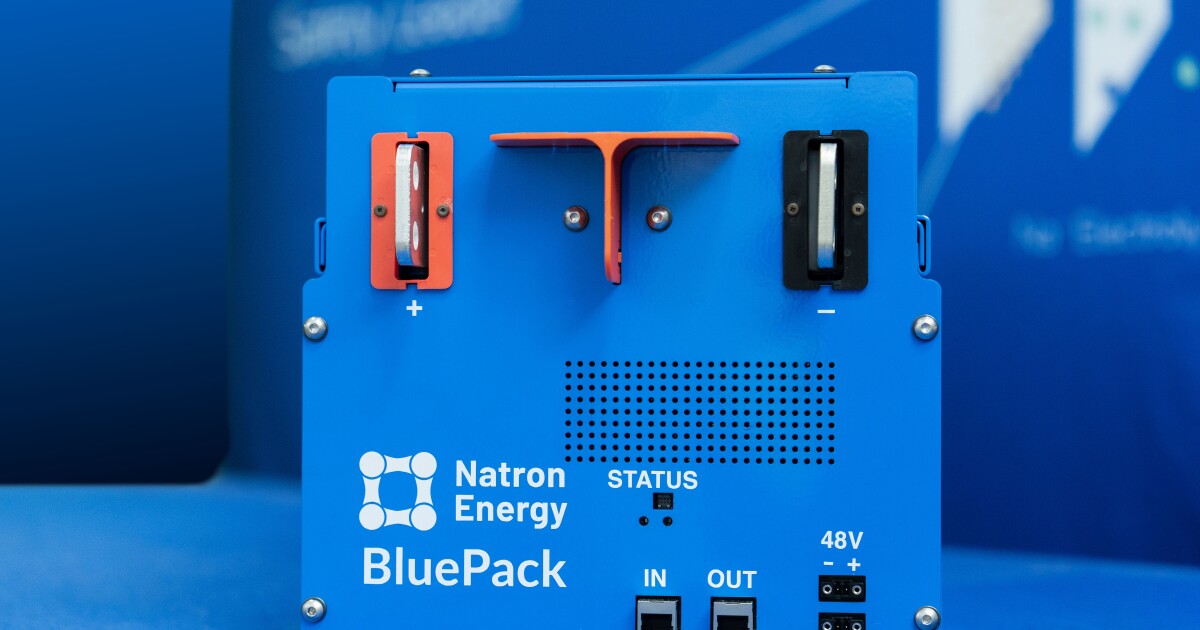Lower power density, higher cycle life, safer. Sounds good for stationary power storage.
…that’s why the article says it.
Listen, if he came to that conclusion in a vacuum without reading the article, that’s kind of neat on its own.
Namaste.
Higher cycle life might also make it good for hybrids, since they cycle their batteries a fair bit.
For sure. They would likely use a lower capacity battery due to these being much less energy dense, though. Hybrids have been using bigger batteries and only using around a 30% zone of charge state in order to greatly prolong battery degradation. I’d imagine auto makers would try to keep the batteries around the same size, but start using more like a 60 or 70% zone, though. So they’ll take advantage of that higher cycle life.
You won’t get an automaker to care about making a battery that lasts much beyond 10 years.
50,000 cycles
Wow, a lifetime of 137 years at one cycle per day. This could make off-grid systems mainstream.
Long-time offgridder here. Would love to have a reasonable alternative to lead-acid or lithium. Opted for lead-acid again on the last battery swap around 5 years ago. Squeezed about 12 years out of the last set -though they were pretty degraded by that time. This bank is depreciating faster, probably because of increased use.
Lead acid batteries seem to be less and less reliable lately. The warranties are shorter and shorter as well, which is the best supporting evidence I have beyond needing batteries more often for the 4-5 vehicles I maintain.
For real. It will take up a lot more space than lithium, but if it lasts way longer and should end up being cheaper, it would definitely be the winning choice. Solar array on the roof and a huge outdoor battery in a shed against the house and no more electric bill, ever.
Build your walls out of batteries and tile your roof with solar panels
Sounds like a fire hazard.
deleted by creator
Heck you can have big windows too!
Batteries degrade with age too. It would probably have to be cycled 10 times a day to get that many cycles.
I could see that happening if these are used in gas hybrid cars, or ev taxis, or maybe grid scale energy buffering
They may work for non plug in hybrids, which have quite small batteries that cycle a lot, but the energy density is far too low for full EV vehicles.
The shitty thing right now is grid connection is required by pretty much any building code, and the utilities are getting wise to solar. They’re moving a lot of the fees from power use to connection and line maintenance. My family was looking at solar, but since 2/3 of their power bill is just to be connected to the grid it wouldn’t save enough to make economic sense.
non-flammable end use
Safe and stable chemistry
Oh neat, finally a non-explody and/or unstable battery lmao
Well, only relatively.
In order to work batteries need to have a certain amount of instability built in, on a chemical level. Them electrons have to want to jump from one material to a more reactive one; there is literally no other way. There is no such thing as a truly “safe and stable” battery chemistry. Such a battery would be inert, and not able to hold a charge. Even carbon-zinc batteries are technically flammable. I think these guys are stretching the truth a little for the layman, or possibly for the investor.
Lithium in current lithium-whatever cells is very reactive. Sodium on its own is extremely reactive, even moreso than lithium. Based on the minimal lookup I just did, this company appears to be using an aqueous electrolyte which makes sodium-ion cells a little safer (albeit at the cost of lower energy density, actually) but the notion that a lithium chemistry battery will burn but a sodium chemistry one “won’t” is flat out wrong. Further, shorting a battery pack of either chemistry is not likely to result in a good day.
I believe it is still better due to raw material availability?
It is definitely that. That’s kind of the point, actually. Sodium is easier to come by than lithium and does not require mining it from unstable parts of the world, nor relying on China.
nor relying on China
The appeal of China is largely in the size of the labor force. Whether this tech is more or less feasible than cobalt and lithium, businesses will still want to exploit the large volume of cheap Chinese labor in order to build them.
I’m sure they’ll want to, but that’ll be a little better than need to, i.e. relying on them for the raw materials as well.
If you consider Australia unstable, sure, maybe for humans, the animals are fine unless you’re Steve Irwin, just dont go diving with stingrays
You who are so wise in the ways of science, can you explain to me if this is safe/will be super dangerous if exposed to water? Doesn’t sodium, like, blow the fuck up when it comes in contact with water?
Well, metallic sodium liberates hydrogen real fast on contact with water, which I guess is tantamount to the same thing.
Yes. But not to the same level as just dropping a brick of pure sodium in a bathtub. In a battery like this there is not pure lithium/sodium/whatever just sloshing around inside. The sodium is tied up being chemically bonded with whatever the anode and cathode materials are. Only a minority of the available sodium is actually free in the form of ions carrying the charge from cathode to anode.
Just as with lithium-ion chemistry batteries, it is vital that the cells remain sealed from the outside because the materials inside will indeed react with air, water, and the water in the air. Exposing the innards will cause a rapid exothermic reaction, i.e. it will get very hot and optionally go off bang.
Okay, that makes a lot of sense. I was asking because I wondered how viable this would be in boats/ships, outdoor areas, off grid cabins, et cetera. Seems like it’s basically the same thing, then, right? Like, proper battery maintenance and you’re good?
If you poke a hole in it, is it just as exciting as lithium?
It is if it’s a dry electrolyte cell.
the notion that a lithium chemistry battery will burn but a sodium chemistry one “won’t” is flat out wrong
Flinging a brick of sodium into my bathtub to prove you wrong.
Post vid, please.
Doesn’t take into account the reactivity difference with the matrix either. Solid state batteries are in a vitrified matrix essentially, and glass don’t burn. Would make a lithium solid state battery likely safer than this.
Lead acid has been there for a hundred years, lithium phosphate is another option.
Nickle-iron
As usual there is absolutely no mention whatsoever anywhere in any of the articles I can find or from the company themselves about what the fucking price is
These aren’t for you to buy directly, they are for manufacturers to negotiate a price and order in bulk from the company to then integrate them into their products or production facilities.
Why would there be? I didn’t think these were for consumers.
Since they say they’re putting them out from 48V to 800V, 48V is what most inverter systems use, so I imagine they’re targetting that size for “consumers” at the single-house PV system size. If the cycle counts and low temperature charging characteristics come true, they will be popular.
American manufacturers like this like to shoot themselves in the foot by pricing their new and innovative battery technology at the datacenter customer size, find out they have no market, use up all their capital, then sell the tech to a big Chinese company like BYD or CATL. So once they’ve complete this lifecycle, I’d expect a couple more years before they’re readily available to actual consumers. Probably expect to see them then at about LFP prices, like $90/kWh wholesale price.
https://diysolarforum.com/threads/upcoming-sodium-ion-batteries.61679/
Late last year they were talking about $40 for a KWH which compared very favourably to LifePO4 that was more like $130 at the time and Li-ion that was more like $200. However right now on alibaba you can get a 200Ah battery for about $60 and the LifePO4 300Ah are now down in the $50 range which is an incredible drop in the space of 6 months. So in practice they are less dense and more expensive but I think its new technology introduction pricing and at some point it should be about a third cheaper than LifePO4 for the same capacity, all be it a bit bigger and heavier and quite considerably cheaper than Li-ion for the same capacity.
The small 18650 and other small sized cells have started appearing on aliexpress as well so its possible to get those too butt they are a lot more expensive than a basic Li-ion 18650 at the moment for a lot less capacity. I think its mostly the bigger cells that most people interested in Sodium Ion will be wanting (home battery and grid storage solutions and some of the low/mid range cars) more than small cells since typically the smaller stuff you want to maximise capacity even if it costs a bit more and most will want li-ion and ideally the newer nearly solid state li-ion that doubles capacity per KG.
You also have to remember these are specifically designed to favor charge cycles over capacity… Only for stationary
The mere fact that we can stop scorching the earth for lithium and cobalt is enough.
Now, we’ll scorch it for salt.
Nuclear bros hate this one simple trick.
Won’t nuclear techy bros use the nuclear energy bits and put them into the sodium thingies to keep them juiced up?
Yeah, I’m not sure why this would be an argument against nuclear power. Does the person above think these batteries are self-charging?
Probably it’s one of those people who didn’t do much in school aside from looking cool
Good video going over practical pros and cons currently:
I couldn’t find much in the chemistry but this seems exciting.
Chemist here. There’s a lot in the chemistry and it is exciting
That is some great news
I didn’t see anything about round trip efficiency. I’ve heard that’s a big downside so it might make energy storage a hard sell.
97% RTe from what I’ve heard.
That would be awesome, any idea where you heard that, I’ve read other sodium based technologies have ~65%
https://www.faraday.ac.uk/wp-content/uploads/2021/06/Faraday_Insights_11_FINAL.pdf (bottom of last column on page 3)
This article is saying 93% but I thought I’d seen 97 somewhere. Might have been marketing bullshit. Though this paper is 3 years old now, so there’s been time for improvement. What hits the market right now may not be up to that number either, so I wouldn’t disbelieve 65% either.
Only thing I’ve seen that has worried me about them is how they seem to have turned a fire hazard into an explosive hazard in terms of battery safety.
Sodium Ion batteries are nonflammable. They are safer than most of what we already use.
Guessing reading comprehension is not your forté.
I’ve probably read more books than you’ve ever smelled. So why don’t you take a big whiff of farts and think on that?
And a shining personality to boot …
What, did you expect a nice response after you replied with an attempt to insult my ability to read? You get what you pay for, dude.
Actually, you replied with just what I expected. I would have been surprised if you simply had tried to reread instead of responding as you did. Enjoy the block, buddy.
















